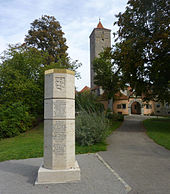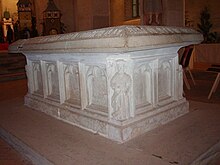Konrad II (Swabia)
Conrad II (February / March 1172 ; † August 15, 1196 in Durlach ) was Duke of Rothenburg (1189–1191) and Duke of Swabia (1191–1196). He was the fifth son of Emperor Friedrich I Barbarossa and his second wife Beatrix of Burgundy .
Life
After the third-born son of the emperor, who was originally called Konrad, was renamed Friedrich around 1170 , this first name, which is steeped in tradition in the Staufer house, was released for a younger son.
Konrad was provided by his father with the Franconian goods that had come to him after the death of Duke Friedrich IV of Swabia in 1167. This happened at the latest in 1188, when he was first referred to as dux de Rotenburch (Duke of Rothenburg ). Then there were Weißenburg and Eger .

On April 23, 1188, Conrad's father Frederick I Barbarossa agreed with King Alfonso VIII of Castile in the Seligenstadt Treaty that Conrad should be married to the Hereditary Princess Berenguela of Castile . In July 1188 the wedding took place in Carrión near Burgos . However, the marriage was never consummated. Pope Celestine III succeeded. to nip in the bud an expansion of the Hohenstaufen to Spain. The connection was canceled between the autumn of 1191 and the beginning of 1192 by the Archbishop Gonzalo of Toledo and the papal legate Gregory, cardinal deacon of San Angelo, on the grounds that the bride had spoken out against the continuation.
Konrad moved with the army under the leadership of his brother Heinrich VI. to Rome for his imperial coronation on April 15, 1191. After the coronation the army set out to conquer the Norman Empire in Sicily . Because of the malaria epidemic that broke out in August 1191 , the campaign in Naples was canceled. Eighteen documents issued in Italy indicate that Konrad took part in this campaign.

Duke Friedrich VI died in January 1191 . von Schwaben , his older brother with the original name Konrad, at the age of almost 24 years in the Third Crusade in front of Acre. According to the chronicle of Otto von St. Blasien in 1191, Heinrich left the Duchy of Swabia to his brother Konrad after he returned from Italy. Konrad was a man of wild nature, but also a generous disposition. He said he did improper things and was a horror to friends and enemies.
In a royal charter from May 24, 1192, when he is said to have received his sword line at a court day in Worms, he appears for the first time as dux Suevie (Duke of Swabia) and from then on his previous designation as Duke of Rothenburg no longer occurs.
The Italian march of Henry VI. In 1194/95 Konrad seems to have stayed away and to have acted as the king's deputy in Swabia and Franconia. This is evident from documents for the Salem Monastery and the Steingaden Monastery , which Konrad issued during this period.
Early death
He died in 1196 at the age of only 24, so still very young by medieval standards. In the annals of Konrad von Scheyern for 1196 it is reported that Konrad was bitten in the left nipple by a girl he was trying to deflower during a campaign against the Duke of Zähringen. Although the blister was growing larger and larger, he did not want to be stopped and died three days later. He died in Oppenheim and was buried in Speyer , both of which are considered incorrect.
According to the chronicle of Burchard von Ursberg , Konrad died during a campaign against Berthold von Zähringen in 1196 in Durlach and was buried in Lorch Abbey. He was killed by the husband of a woman whom he had forced adultery or by the woman herself. Because he was a man who committed adultery, fornication, rape, any debauchery and indecency. Nevertheless he was strong in the war, courageous and generous towards his friends, both his own and strangers trembled before him. The Marbach Annals date his death on August 15, 1196.
Konrad was buried in the Lorch monastery , the tomb of the Staufers donated by his great-grandfather, Duke Friedrich I of Swabia . In 1475, Abbot Nikolaus Schenk von Arberg had the remains of all the Hohenstaufen buried in Lorch reburied in a late Gothic tomb , which today stands in the central nave of the Lorch monastery church.
Konrad's early death in 1196 prevented him from becoming heir to the throne of Emperor Heinrich VI, who died in Messina in September 1197 only one year after him. could be. Instead, his younger brother Philipp inherited him as Duke of Swabia and became the next king of the Hohenstaufen family in 1198.
literature
- Franz-Josef Jakobi: Konrad II of Rothenburg. In: New German Biography (NDB). Volume 12, Duncker & Humblot, Berlin 1980, ISBN 3-428-00193-1 , p. 527 f. ( Digitized version ).
- Peter Rassow : The Prince Consort. A Pactum Matrimonale from 1188. Weimar 1950.
- Hansmartin Schwarzmaier : Konrad von Rothenburg, Duke of Swabia. A biographical attempt. In: Württembergisch Franken Vol. 86 (2002), pp. 13–36.
- Paul Friedrich von Stälin : Konrad II. In: Allgemeine Deutsche Biographie (ADB). Volume 16, Duncker & Humblot, Leipzig 1882, p. 619.
- Tobias Weller : The marriage policy of the German nobility in the 12th century. Böhlau, Cologne 2004, ISBN 3-412-11104-X , pp. 143–155.
Web links
Individual evidence
- ↑ Dating of the birth according to Erwin Assmann : Friedrich Barbarossas Kinder . In: German Archives for Research into the Middle Ages, Vol. 33 (1977), pp. 435–472, here: p. 459.
- ↑ Gerhard Baaken : The age sequence of the sons of Friedrich Barbarossa and the ascension of Henry VI. In: German Archives for Research into the Middle Ages, Vol. 24 (1968), pp. 46–78, here: p. 75.
- ↑ Stälin p. 619.
- ^ Stauferstele Rothenburg on stauferstelen.net. Retrieved January 1, 2017.
- ↑ MGH DD FI, Volume 4, No. 970 , pp. 247-251.
- ^ Peter Koblank: Treaty of Seligenstadt 1188. on stauferstelen.net. Retrieved July 25, 2016.
- ↑ Weller, pp. 152-154.
- ↑ Schwarzmaier p. 28.
- ↑ Continuatio Sanblasiana , MGH SS 20, p. 323 , lines 45-47.
- ↑ Schwarzmaier p. 29.
- ↑ Schwarzmaier p. 30.
- ↑ Chounradi Schirensis Annales , MGH SS 17, p. 631 , lines 22-25.
- ↑ a b Weller pp. 154–155.
- ↑ Burchardi et Cuonradi Urspergensium Chronicon , MGH SS 23, p. 364 , lines 38-44.
- ↑ Annales Marbacenses , MGH SS 17, p. 167 , lines 28-29.
- ^ Hansmartin Decker-Hauff : The Staufer House . In: Württembergisches Landesmuseum (Hrsg.): The time of the Staufer. History - art - culture . Stuttgart 1977, Volume III, pp. 339-374, here: p. 356.
- ↑ Tomb of the Hohenstaufen in Lorch Abbey on klosterlorch.de. Retrieved June 28, 2020.
| predecessor | Office | successor |
|---|---|---|
| Friedrich VI. |
Duke of Swabia 1191–1196 |
Philip |
| personal data | |
|---|---|
| SURNAME | Konrad II. |
| ALTERNATIVE NAMES | Konrad von Rothenburg |
| BRIEF DESCRIPTION | Duke of Swabia and Duke of Rothenburg |
| DATE OF BIRTH | February 1172 or March 1172 |
| DATE OF DEATH | August 15, 1196 |
| Place of death | Durlach |

